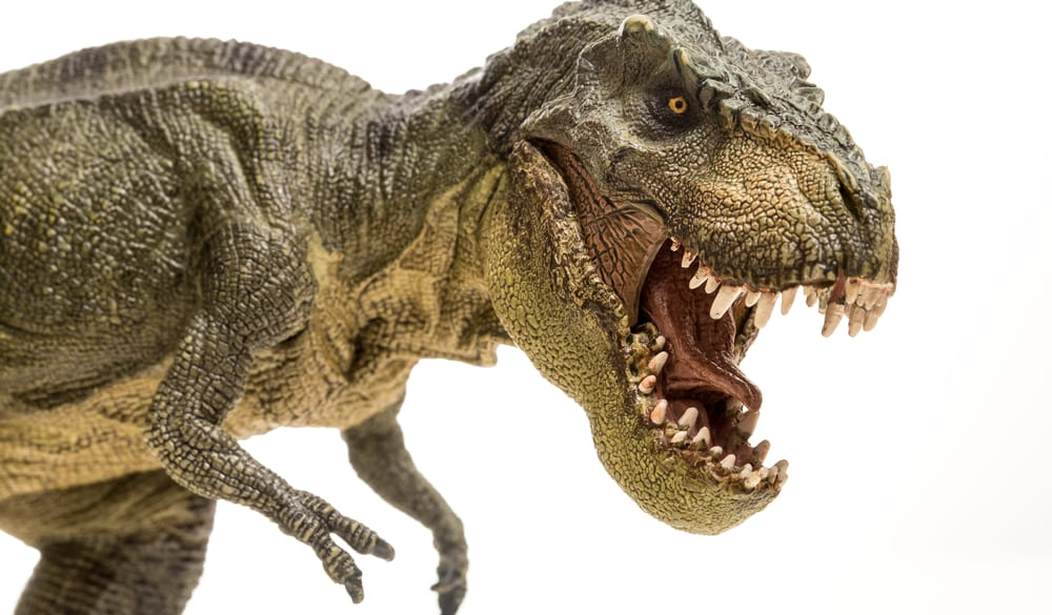If you ever overhear anyone complaining that the Tyrannosaurus rex from Jurassic Park wasn’t “scientifically accurate” for not rocking full-body bird plumage, you have two simple ways to correct them:
1. Ask why they slept through Mr. DNA’s clear-cut explanation of how the genetic scientists at Jurassic Park had to fill in the gaps in their dinosaur DNA with other animals to complete the DNA code; of course the hybrid lab-grown dinosaurs weren’t going to look or act anything like their long-extinct counterparts!
2. Tyrannosaurus rex did not have feathers.
As someone who has loved dinosaurs from a young age, I quickly got sick of the theories that the iconic Tyrannosaurus rex was essentially Big Bird with teeth. After growing up with the fact that T-Rexes had scaly skin, followed by the reported studies that the lizard king may have been covered in “downy feathers,” new research of Tyrannosaur skin shows that these dinosaurs were not covered in feathers, and I couldn’t be happier. National Geographic reports:
Today, thanks to a study of fossilized dinosaur skin published in Biology Letters, we may finally have an answer. [Paleontologist Scott] Persons and his colleagues examined new skin impressions taken from T. rex fossils discovered near Baker, Montana, and compared them with fossils of other tyrannosaurs, including Albertosaurus, Daspletosaurus, Gorgosaurus, and Tarbosaurus.
The team found a pattern among the tyrannosaur kin: they all had skin textured with small, pebbly scales and not fuzzy plumage.
“Now that we’ve found these multiple patches of preserved tyrannosaur hide from multiple places across the body, it looks pretty clear that at least the majority of the T. rex was not covered in feathers,” says Persons.
While the fossilized scaly skin proves that the Tyrannosaurus rex clearly didn’t have feathers on its chest, torso, tail, back, and neck, some paleontologists hypothesize that just because feathers were not preserved with the rest of the fossilized animal, it doesn’t mean that the massive hunter did not have feathers — just that they weren’t preserved along with the dinosaur’s skin and bones. The sample skin fossils analyzed in the study were taken from Tyrannosaurus rex and four other similarly built carnivorous theropods: Tarbosaurus, Daspletosaurus, Gorgosaurus, and Albertosaurus.
This is tyrannosaur skin! #UAlberta #science #dinosaurs pic.twitter.com/ZwN08xOg2D
— Scott Persons (@WScottPersons) June 7, 2017
As the massive dinosaur nerd that I am, I will proudly admit that I have a few models around the office, specifically a Vagaceratops, Iguanodon, and Dilophosaurus, and as much as I love Safari Ltd. for their expertly detailed, hand-painted models, I feel bad that they just released their now-unscientific, brand-new “Feathered Tyrannosaurus Rex” model this year. Safari’s product page even notes that “recent discoveries of feathered dinosaurs are changing our understanding of the life appearance of this popular species.”
Oops.
While there are still many things that we don’t and will likely never know about the Tyrannosaurus rex, such as its skin color, what it sounded like, or what the “tyrant lizard” used its relatively puny arms for, that doesn’t mean that we have never changed our perception about these extinct reptiles.
For instance, dinosaurs were initially portrayed as lumbering and plodding beasts that dragged their tails on the ground like alligators. After studying dinosaur tracks, scientists realized that the vast majority of these imprints didn’t include tail traces that followed their footsteps, which indicated that the dinosaurs weren’t the tail-draggers depicted in the classic 1933 creature feature, King Kong.
But seriously, people need to stop whining about the lack of feathered dinosaurs in Jurassic Park and start questioning how in the world the T-Rex got into the Visitor’s Center at the end of the film. Life finds a way, I suppose…










Join the conversation as a VIP Member